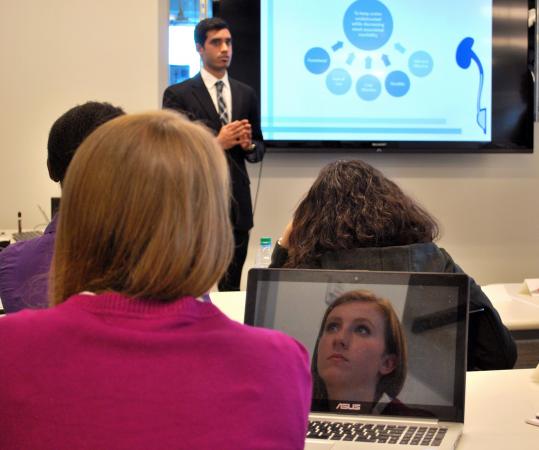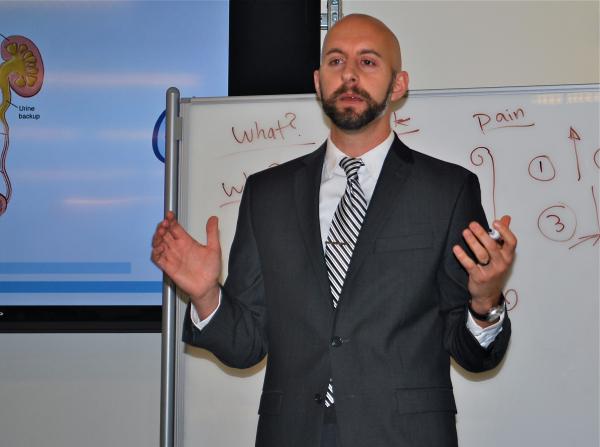The Master of Biomedical Innovation and Development Biomedical Innovation and Development (BioID) was created specifically to develop a new generation of biomedical leaders and entrepreneurs who can expertly bridge the gap between the bench and the bedside, turning biomedical research into practical therapies and products for improving patient care.
“This is very real-world, practice-based training in the development of medical devices and biomedical products,” says Sathya Gourisankar, director of the BioID program, who brings 30 years of medical device industry research and development experience to his role, including project management, pre-clinical and clinical biomaterials research, and regulatory submissions. “We offer very holistic and balanced training so that, by the end of this intense one-year program, our students will have a good grasp of all the processes and linkages needed to convert an idea into a product reality that addresses an unmet clinical need.”
Offered by the Wallace H. Coulter Department of Biomedical Engineering (BME), and now in its second year, BioID gives students access to industry experts and insights, enabling them to study a wide range of career possibilities while learning how to carefully navigate the product development process. The three-semester program begins in August with the fall semester and runs through July.
BioID has more than doubled in size since its debut in August 2013 with 10 students (last year’s batch of students, who graduated on August 1, 2014, were all placed, and some received multiple offers prior to graduation). This year’s class of 21 students is a diverse group in terms of gender, residency and background – 12 female, nine male, 10 from other states, six from other nations.
Some students come from the professional world, physicians like Lance Black, who became frustrated with poorly designed medical equipment while practicing in the U.S. Air Force, and chose to leave clinical practice so he could improve the situation by learning more about the practical translational aspects of research and innovation with the hope of developing better medical devices. And other students, like Erin Roberts, are taking the next logical step in their education as they try to launch their fledgling biomedical careers.
“So far, it’s been an intense and well-rounded experience,” says Roberts, whose undergraduate degree is in biology engineering, with a biomedical emphasis. “I had an internship at Caterpillar, and though it wasn’t the biomedical industry, it did show me the manufacturing and business side, and that appealed to me more than the idea of academia and research. I felt like this program would give me the tools I needed to transition into the medical device industry.”
The BioID students work in teams of five or six, with different individual strengths matched together. Early in the fall semester, Gourisanker brings in a handful of clinicians and experts to pitch different sets of problems or unmet needs and the students may choose one to address. For example, Roberts’ team, Nuvo Khoja, is developing a better hernia repair device, addressing a problem presented by a clinical mentor.
At the end of each semester, the teams meet and make presentations, in which they summarize the status of their projects. Recently, the current BioID class held its first end-of-semester presentation at program headquarters, Technology Enterprise Park, where students have access to state of the art classroom and conference space and business facilities as well as a fully equipped machine shop where they can create product prototypes.
The four teams (MedaWorks, MEDlanta, Nuvo Khoja, and Paxor) took turns giving their reports, each student getting a chance to practice their presentation and public speaking skills at the front of the room, while associate director of BioID (and Parker H. Petit Institute for Bioengineering and Bioscience member) Julia Babensee looked on, and Gourisankar sat near the front of the class, occasionally peppering the presenters with helpful insights and probing questions.
By the end of the third semester, in July 2015, each team will conceivably have a pre-clinical prototype, a potentially successful answer to a clinical problem. Along the way, the students also will have charted a certain career path, thanks in part to the massive amount of networking the BioID program affords them, in the way of world-class guest lecturers – clinicians, entrepreneurs, FDA experts and others who share their career case studies.
“That has been extremely helpful, the guest speakers we see on a daily and weekly basis. It’s really helped me narrow down my career interests,” says Roberts, who has become particularly interested in regulatory affairs. “You get so much experience and exposure in a short time. And I mean exposure to virtually every type of job you can have within a medical device company. What I’ve learned here since August has been like a year’s worth of education in any other setting.”
Media Contact
Jerry Grillo
Communications Officer II
Parker H. Petit Institute for
Bioengineering and Bioscience
Keywords
Latest BME News
Jo honored for his impact on science and mentorship
The department rises to the top in biomedical engineering programs for undergraduate education.
Commercialization program in Coulter BME announces project teams who will receive support to get their research to market.
Courses in the Wallace H. Coulter Department of Biomedical Engineering are being reformatted to incorporate AI and machine learning so students are prepared for a data-driven biotech sector.
Influenced by her mother's journey in engineering, Sriya Surapaneni hopes to inspire other young women in the field.
Coulter BME Professor Earns Tenure, Eyes Future of Innovation in Health and Medicine
The grant will fund the development of cutting-edge technology that could detect colorectal cancer through a simple breath test
The surgical support device landed Coulter BME its 4th consecutive win for the College of Engineering competition.









